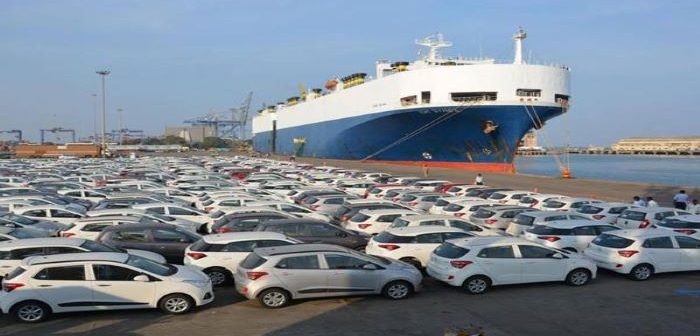India’s vehicle export market witnessed a significant upturn in the first half of the 2024-25 fiscal year. The surge reflects the growing global demand for Indian-manufactured vehicles and the strategic positioning of India as a competitive exporter in the automotive sector. This report explores the key drivers of the export growth, presents the latest data, and analyzes the sector’s future prospects.
Growth Overview
India exported over 2.5 million units of vehicles between April and September 2024, representing an approximate 15% increase from the same period in FY 2023-24. This surge is largely driven by strong demand in the Latin American, African, and Southeast Asian markets, where Indian vehicles—especially two-wheelers, three-wheelers, and small passenger cars—continue to gain popularity due to their cost-effectiveness and reliability.
Key Drivers of Export Growth
- Expanding International Markets: Indian automakers have expanded their presence in markets like Mexico, South Africa, and Indonesia, where the demand for affordable vehicles has seen exponential growth. Companies like Tata Motors, Maruti Suzuki, and Bajaj Auto have actively increased exports to these regions.
- Electric Vehicle (EV) Exports: With India’s strong push towards EV manufacturing, the country’s exports in this segment have also experienced a sharp rise. A 35% increase in EV exports was recorded, with countries such as the UK and Germany becoming major importers of India’s electric two-wheelers and buses.
- Competitive Manufacturing Costs: India’s relatively low production costs, backed by a strong supply chain ecosystem, are making it an attractive destination for vehicle manufacturing. With global automakers setting up bases or expanding operations in India, export volumes have risen as these vehicles meet international standards at competitive prices.
- Favorable Trade Policies: The Indian government’s continued emphasis on export-friendly policies, including incentives under schemes like the Production-Linked Incentive (PLI) scheme for the automotive sector, has bolstered the capacity of automakers to export. Additionally, bilateral trade agreements with countries in Africa and Latin America have reduced export barriers.
Export Breakdown by Vehicle Category
- Two-Wheelers: The segment continues to dominate Indian vehicle exports, accounting for nearly 50% of the total. Brands like Bajaj and TVS have cemented their leadership positions in key markets like Africa, where motorcycles are essential for last-mile connectivity.
- Passenger Vehicles (PVs): Passenger car exports rose by 12% during the period, with Maruti Suzuki leading the way. Hatchbacks and compact SUVs, in particular, have seen heightened demand due to their affordability and fuel efficiency.
- Commercial Vehicles (CVs): The commercial vehicle segment, which includes trucks and buses, recorded a growth of 8% in exports. Indian-made commercial vehicles, known for their durability, have become a popular choice in emerging markets across Africa and Southeast Asia.
- Electric Vehicles (EVs): India’s export of electric two-wheelers and electric buses saw a major spike, particularly to Europe and Southeast Asia. Several states in India have introduced supportive policies to make EV production more efficient, contributing to the growth of exports in this segment.
Major Export Destinations
- Mexico remains a top destination for Indian vehicle exports, particularly in the two-wheeler and small car segments.
- South Africa and Nigeria lead the demand in Africa, while Indian vehicles are gaining traction in the Middle East and Southeast Asia, especially in Indonesia and the Philippines.
Leading Indian Exporters
- Maruti Suzuki: Dominating the passenger vehicle export market, Maruti Suzuki saw a growth of 10% in exports, driven by strong demand for its compact cars like the Swift and Baleno in Latin American and African markets.
- Tata Motors: Tata’s portfolio of passenger and commercial vehicles helped it register a 13% increase in exports. The company is particularly seeing success in the EV segment in Europe.
- Bajaj Auto: Bajaj continues to lead the two-wheeler export market, with a sharp rise of 18% in exports to key markets like Nigeria and Egypt.
- TVS Motor Company: TVS maintained a strong presence in Latin America and Africa, with a 14% rise in two-wheeler exports.
Future Outlook
India’s vehicle export growth is expected to continue in the latter half of FY 2024-25, driven by:
- Increased EV production: With India’s aggressive push towards electric mobility, the global demand for EVs is likely to continue rising, especially from developed nations seeking affordable EV options.
- Sustained Demand from Developing Economies: Emerging markets in Africa, Latin America, and Southeast Asia will remain key targets for Indian automakers, as these countries experience rising demand for low-cost mobility solutions.
- Trade Partnerships: Ongoing and future trade agreements with key regions are set to enhance India’s export potential, further cementing its position as a major global vehicle exporter.
In conclusion, the first six months of FY 2024-25 have underscored India’s growing strength in vehicle exports. The rise in demand across international markets, combined with a strong domestic manufacturing base, positions India well to continue its trajectory as a global automotive export powerhouse.






